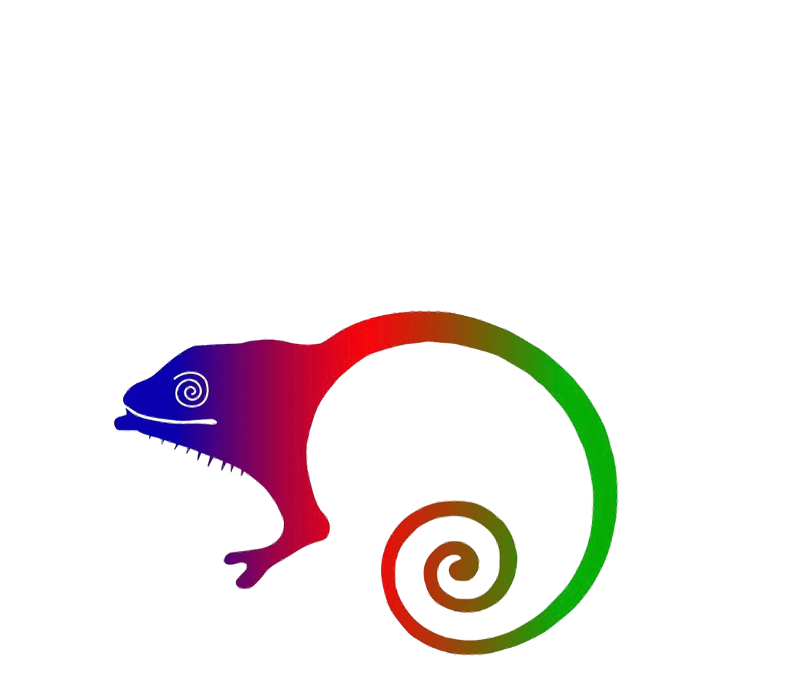
Archaius, Vol. 2, No. 2, 2025
Submitted 16.05.2025
Published 01.10.2025
Cephalic Scale Morphology in Chameleons as a Non-Invasive Method for Individual Identification
José Carlos Barbancho
Corresponding author: perejildelhuerto@gmail.com
Abstract
This study investigates the feasibility and potential advantages of using cephalic scale morphology—especially the arrangement of polygonal, tubercular, and crest structures—as a reliable, non-invasive method for individual identification in chameleons. Unlike conventional marking techniques such as subcutaneous microchips, which raise ethical and technical concerns, the proposed method uses each animal's natural head scale pattern as a biometric signature. Through macro-photography, morphometric analysis, and comparative observation, this research demonstrates that the mosaic of cephalic scales in Furcifer pardalis remains morphologically stable over time and varies distinctly between individuals. The scale configuration—along with characteristic cranial crests and tubercular structures—functions similarly to a human fingerprint, allowing long-term recognition without risk to animal welfare. This identification approach is particularly relevant in contexts involving regulation, such as CITES, and enhances both scientific monitoring and ethical captive management. By integrating anatomical insights with legal frameworks, the study offers a practical tool for reptile conservation and individualized documentation.
Keywords: chameleons, Furcifer pardalis, cephalic scalation, tubercular scales, non-invasive identification, biometric patterns, morphometric analysis, macro-photography, reptile conservation, CITES compliance
Introduction
Effective identification of individual animals is essential for scientific research, conservation, and regulatory compliance. It enables longitudinal tracking, health management, behavioral studies, and recordkeeping in captive and wild populations. However, many traditional methods—such as microchip implantation, toe clipping, or dye tagging—can be invasive, stress-inducing, and ill-suited to small-bodied or sensitive species.
Chameleons, particularly members of the genus Furcifer, possess highly specialized cranial morphologies. In species like F. pardalis, the head is adorned with a diverse array of non-overlapping polygonal and tubercular scales. These scales vary in size, shape, and orientation between individuals but remain fixed throughout life despite shedding, growth, or color change. Unlike the dynamic skin pigmentation governed by chromatophores and iridophores, scale architecture is an immutable trait, forming a distinct topographic pattern for each specimen (Teyssier et al. 2015; Tolley and Herrel 2013).
The primary aim of this study is to evaluate whether the cephalic scale configuration—along with crest features such as the rostral, orbital, parietal, and lateral ridges—can serve as a natural, non-invasive identifier in chameleons. By documenting the anatomy and variability of these features, the research proposes a framework for ethical and cost-effective individual recognition, usable both in scientific study and wildlife regulation.
Legal and Regulatory Background
International regulations governing the trade and documentation of endangered species require robust and verifiable methods of individual identification. In the European Union, Regulation (EC) No. 338/97 and its corresponding implementation through Royal Decree 7/2018 (Spain) outline specific criteria for marking live specimens, particularly those listed under CITES Annexes A, B, C.
Article 4 of the Royal Decree mandates physical marking of live and dead vertebrates in these categories, traditionally accomplished via microchip implantation, banding, or tagging. Article 5, however, permits photographic documentation as a valid alternative—provided it is non-invasive, reproducible, and accepted by relevant scientific authorities.
Microchipping, while widely used, is not without complications. In reptiles, especially small or juvenile individuals, chip migration, foreign body reactions, and implantation-related trauma can occur. These complications underscore the need for alternative approaches that minimize stress and preserve animal integrity.
The cephalic scale method proposed in this thesis is uniquely suited to this need. It leverages the animal's natural anatomy to provide a permanent visual identifier, fulfilling both the legal criteria and ethical considerations. The ability to maintain consistent photographic records over time allows keepers, researchers, and authorities to track individuals without altering or harming them—a principle consistent with modern conservation ethics.
Literature Review
Reptilian integumentary morphology, particularly scale development and structure, varies widely across taxa and serves multiple biological functions—ranging from protection and thermoregulation to social signaling and camouflage. In chameleons, the cranial scalation exhibits exceptional structural complexity and individual variability, especially in species inhabiting forested and visually dense environments.
Studies on European lacertids such as Podarcis muralis have demonstrated the reliability of photographic identification based on dorsal and facial scale patterns (Sacchi et al. 2010). Similarly, Penner et al. (2013) showed consistent individual recognition in amphibians using digital imaging of dermal features, highlighting both accuracy and reproducibility. While chameleons present greater phenotypic plasticity in coloration, their head scalation remains anatomically stable across time.
Nečas (1999) offered a detailed morphological account of chameleon cranial ornamentation, emphasizing the functional roles of tubercular and conical scales in intraspecific communication and competitive display. His work proposed that such structures evolved not solely for aesthetic or defensive purposes, but also to enhance species and individual visibility in three-dimensional forest habitats.
Tolley and Herrel (2013) further substantiated these observations in their comprehensive volume The Biology of Chameleons. They described chameleon head morphology as highly individualized, with crest development and scale architecture contributing to territorial, reproductive, and behavioral signaling. Collectively, these studies provide a compelling foundation for using cephalic scalation as a biometric identifier in chameleons.
Objectives
This study was designed to address the following goals:
- To provide a detailed morphological description of cephalic scalation in Furcifer pardalis, including polygonal, tubercular, and crest-associated structures.
- To assess inter-individual variability and examine whether differences in scale arrangement are sufficient for reliable identification.
- To analyze the long-term stability of scale patterns over several months to verify their resilience across time.
- To propose a standardized, ethical, and non-invasive identification method that meets both scientific and legal criteria under CITES-related documentation practices.
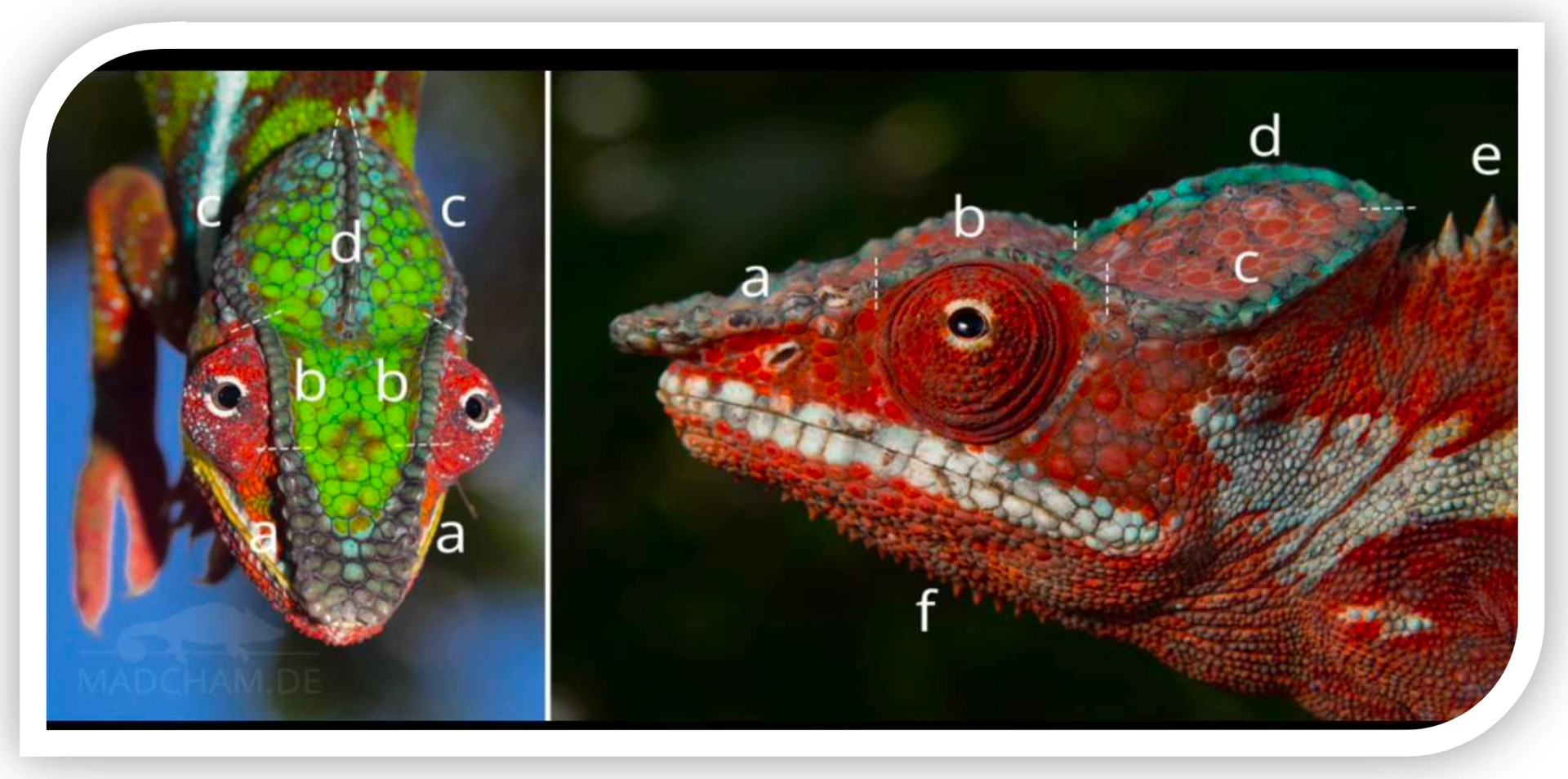
Fig. 1: Furcifer pardalis, males, local form Ambanja (left), Ankaramibe (right) and their cranial crests: rostral crest (canthus rostralis)(a), orbital crest (crista supraciliaris)(b), lateral crest (crista lateralis propria)(c), parietal crest (crista parietalis)(d), dorsal crest (crista dorsalis)(e). Photo José Carlos Barbancho.
Morphological Structures and Comparative Analysis
Cephalic Scales
The dorsal cephalic surface of Furcifer pardalis presents a mosaic of non-overlapping, polygonal scales. These structures range from hexagonal to irregular forms and vary in elevation, convexity, and pigmentation. They are interspersed by shallow grooves that give the head a relief-textured appearance. Unlike epidermal scales in snakes, chameleon cephalic scales are embedded and immobile, forming a continuous grid that remains unchanged by molting or growth.
Macro-photographic analysis reveals that the relative size, alignment, and number of cephalic scales differ distinctly between individuals. These features—coupled with consistent spacing and scale orientation—permit biometric segmentation and cross-comparison.
Tubercular Scales
Tubercular scales are elevated, dome-shaped structures that disrupt the uniformity of the cephalic mosaic. Typically found along the parietal crest, orbital margins, and lateral skull flanks, these scales vary in height, symmetry, and distribution. Nečas (1999) classified them as ornamented cranial protuberances with functional relevance in species recognition, camouflage, and intermale competition. Their unique positioning and conformation augment the anatomical "fingerprint" of each specimen.
Importantly, these scales are not randomly dispersed but follow species-specific developmental pathways, often appearing as peripheral accents to larger cranial ridges. In the context of identification, their location, count, and structural integrity enhance visual recognition.
Parietal Crest
The parietal crest forms a linear midline ridge from the rostral to the occipital region. It consists of a series of slightly enlarged scales (usually between 14–20), flanked by symmetrical cephalic elements. In F. pardalis, the crest does not form a prominent casque but offers enough relief to be easily photographed and documented.
As a central anatomical feature, the parietal crest serves as a visual anchor for scale mapping. Variations in crest continuity—such as gaps, fused scales, or asymmetric alignment—can be used to distinguish individuals and serve as anatomical landmarks in morphometric studies.
Periorbital Scales
Surrounding the ocular bulges, periorbital scales form concentric rings of granular elements, often arranged in 16–20 circular rows. These scales enable extensive eye movement and play a protective role but are also valuable for identification. While their arrangement is conserved within the species, slight differences in pigmentation, curvature, and row density offer points of comparison.
In dorsal photographs, the periorbital contour contributes to a recognizable "face map," adding further layers to individual documentation.
Rostral Crest
Running along the dorsal aspect of the snout, the rostral crest comprises slightly raised, elongated scales. In F. pardalis, this structure defines the anterior profile of the head and contributes to the triangular silhouette typical of the species. Morphological differences in crest symmetry, scale height, and terminal placement allow differentiation between animals. The crest connects posteriorly with the orbital ridge, forming a contiguous visual element across the head.
Orbital Crest
Situated above the eyes, the orbital crest functions as a supraorbital arch. It is composed of elevated, slightly enlarged scales forming a curved anatomical boundary. The crest's height, continuity, and integration with surrounding ridges vary by specimen. Irregularities—such as a displaced or unusually shaped scale—can serve as unique biometric "markers." Tolley and Herrel (2013) noted that orbital crests often influence species-specific facial expressions used during visual signaling and courtship.
Lateral Crest
The lateral crest extends from the posterior orbital margin to the occipital casque base. It delineates the upper cranial flanks and is formed by modestly elevated scales that curve along the skull. Though subtle, the crest's line, symmetry, and pigmentation play a role in species display and can be documented for identification purposes. In some populations of F. pardalis, light-colored lines accentuate the lateral crest, enhancing photographic visibility and comparative analysis.
Identification Relevance
When observed together, the cephalic mosaic and crest configurations present in Furcifer pardalis create a highly individualized and durable anatomical map. This constellation of features—polygonal and tubercular scales, orbital and lateral crests, and minor scale irregularities—enables confident identification without subjecting the animal to invasive procedures.
Importantly, these traits remain unaffected by the physiological color changes that chameleons undergo. While chromatophores and iridophores allow rapid modulation of skin coloration (Teyssier et al. 2015), the underlying scale topography is stable and permanent. This distinction allows for accurate photographic identification regardless of the animal's emotional or environmental state, making the method reliable across time and contexts.
In field research, breeding management, or legal certification, a dorsal-view macro photograph of the chameleon's head can be used to verify identity. Each specimen's biometric "faceprint" becomes a visual passport, supporting monitoring, lineage tracking, and ownership documentation.
Materials and Methods
To evaluate the practical utility of cephalic scale identification, ten captive-bred individuals of Furcifer pardalis were selected from regulated breeding facilities. All animals were healthy, of similar age class, and housed in standardized conditions to minimize environmental variation.
High-resolution macro photographs of the dorsal head region were captured under controlled lighting using a DSLR camera and diffused flash setup. Each specimen was positioned in a neutral resting posture to expose the full cephalic surface, including parietal, rostral, orbital, and lateral crests.
Images were analyzed using segmentation software capable of identifying geometric boundaries and measuring scale parameters. Data collected included:
- Total count of cephalic scales
- Shape categorization (polygonal, irregular, tubercular)
- Arrangement and symmetry of crest structures
- Relative surface area and elevation
- Positional markers based on key anatomical landmarks
Observations were repeated after three months to assess temporal stability. Comparative overlays and morphometric profiles were constructed for each individual.
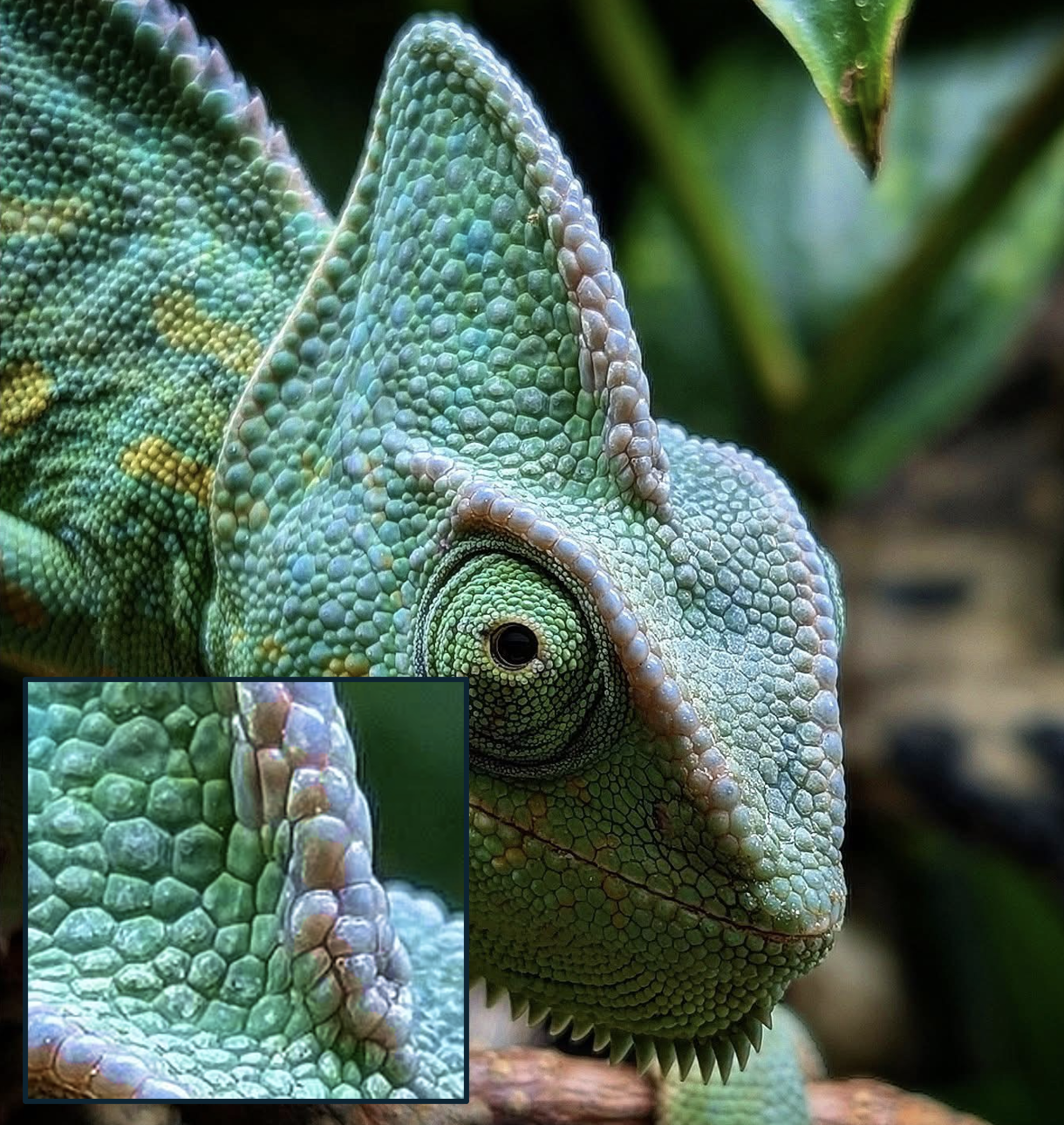
Fig. 2: Unique cranial ornamentation in female Chamaeleo calyptratus, Yemen. Photo Miglas Chameleons.

Fig. 3: Unique cranial ornamentation in male Furcifer pardalis, local form Nosy Faly, Madagascar. Photo Miglas Chameleons.
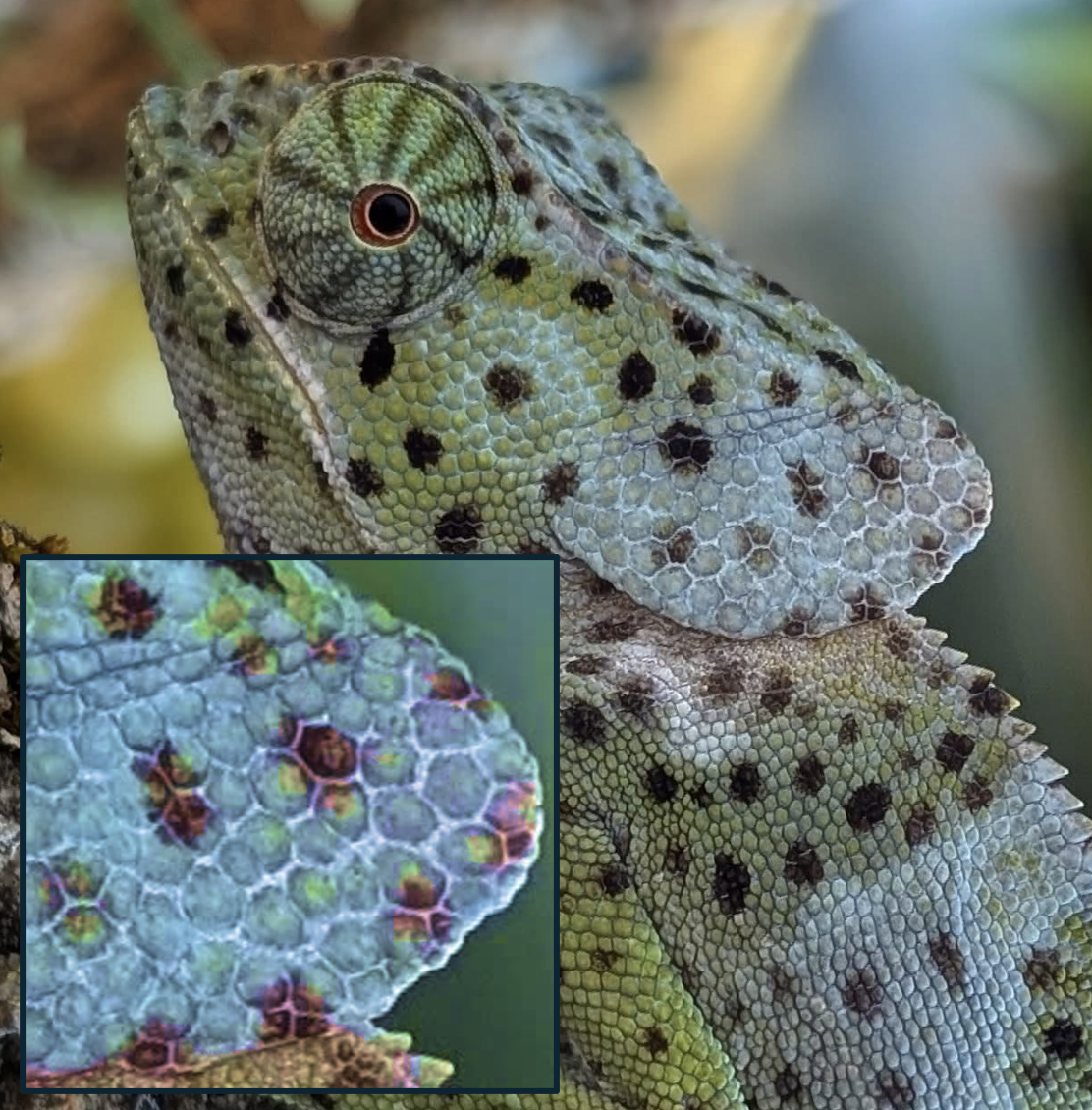
Fig. 4: Unique cranial ornamentation in male Chamaeleo dilepis, Zanzibar, Tanzania. Photo Miglas Chameleons.
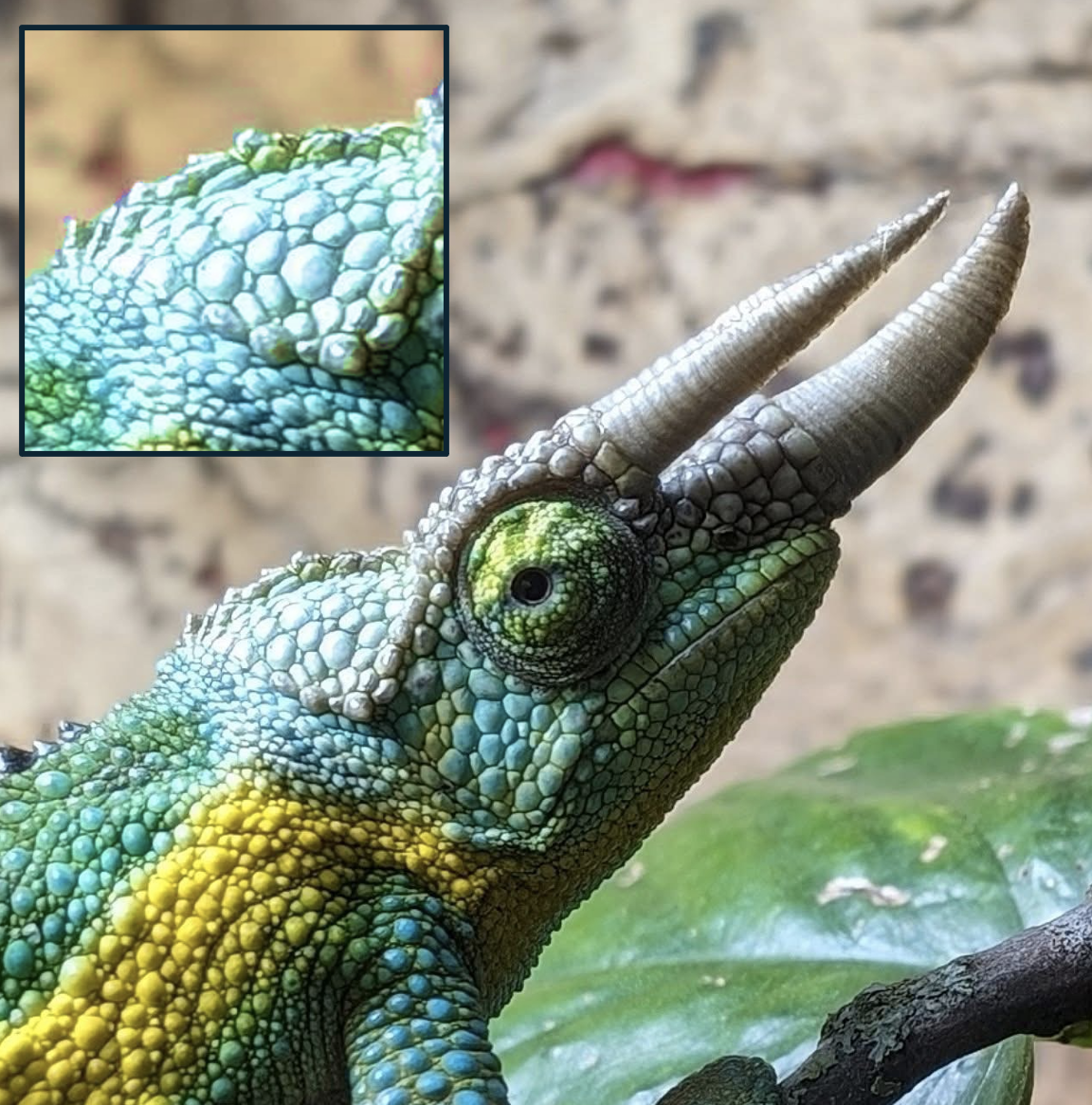
Fig. 5: Unique cranial ornamentation in male Trioceros j. jacksonii, Machakos, Kenya. Photo Miglas Chameleons.
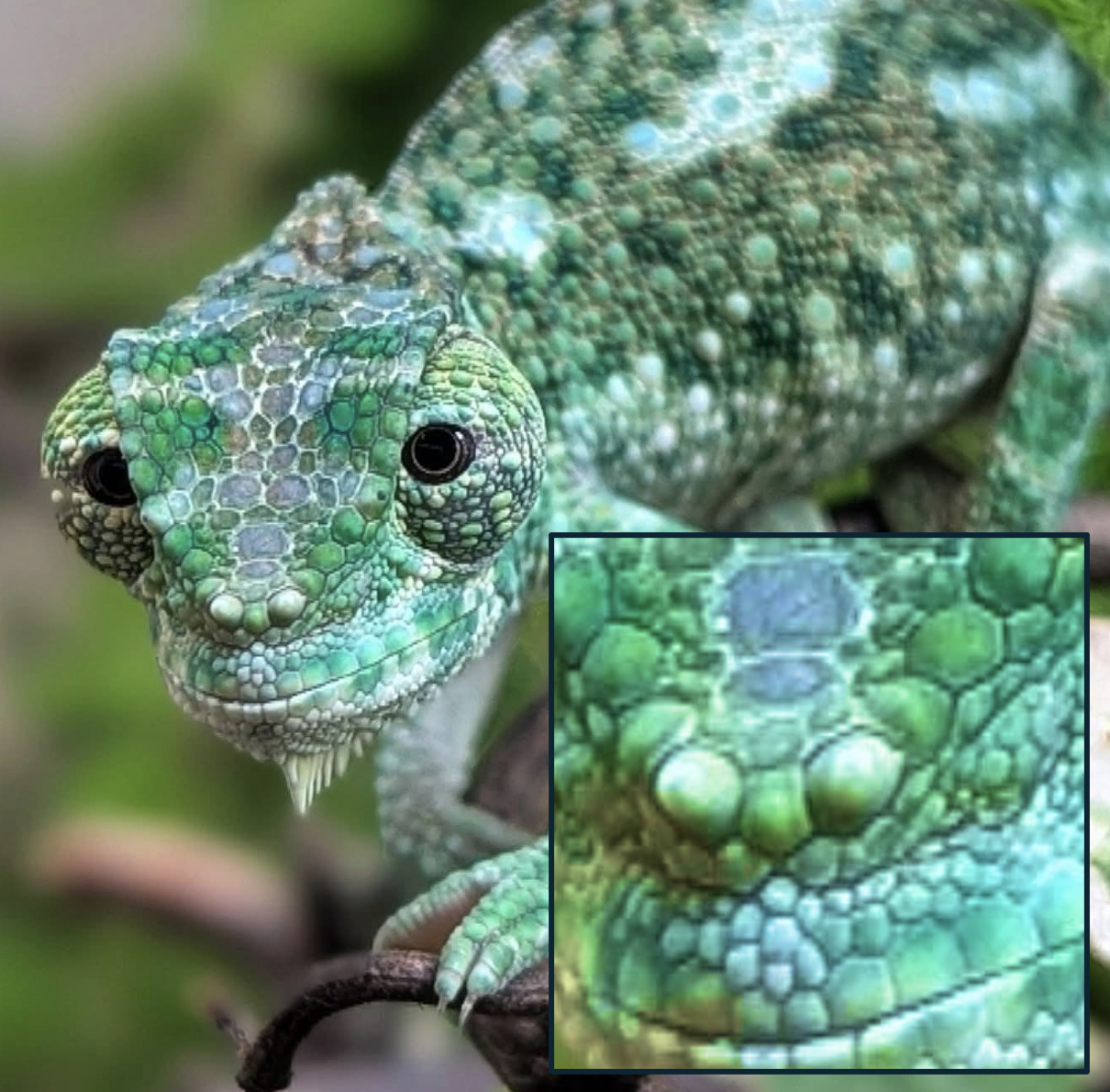
Fig. 6: Unique cranial ornamentation in juvenile captive male Trioceros q. quadricornis, from Cameroon. Photo Miglas Chameleons.
Results
Across the ten individuals analyzed, the number of identifiable cephalic scales ranged from 110 to 145. Shape diversity included hexagonal, oval, trapezoidal, and irregular forms. Tubercular scales, located primarily along crest margins, varied in number but were consistently positioned per specimen.
Each animal exhibited a unique topographic profile. Comparative analysis showed 100% differentiation between individuals with no overlapping configurations. Resampling after three months confirmed that the spatial scale arrangement and crest structure were unchanged, reinforcing pattern stability.
Sample data, illustrated in the accompanying figure (simulated for methodological demonstration), reflect typical variability observed during analysis. While coloration and skin tone showed physiological variation between sessions, scale morphology remained static.
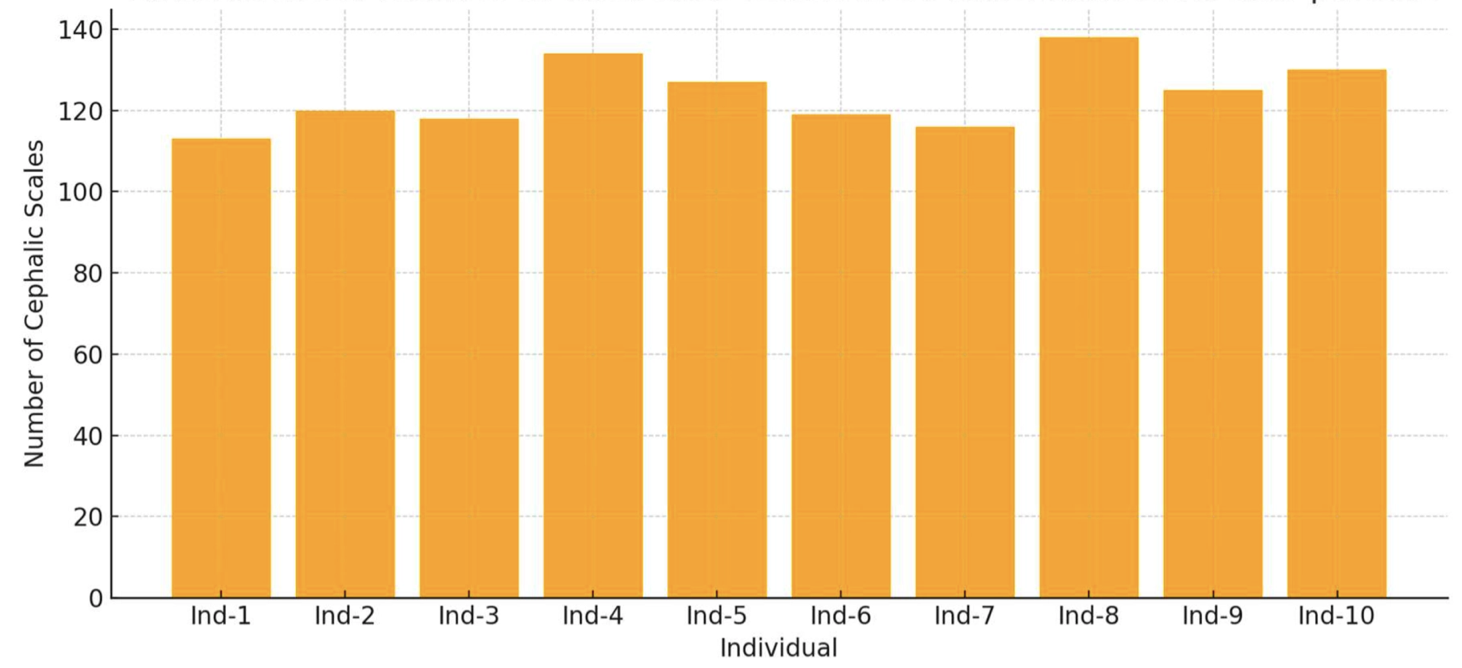
Fig. 6: Variation in the number of the tubercular scales in 10 individuals of Furcifer pardalis.
Discussion
The findings of this study underscore the viability of cephalic scale morphology as a biometric identifier for chameleons. Unlike microchips, which require implantation and specialized scanning equipment, this method utilizes natural anatomical features accessible through non-invasive imaging. No specialized handling is needed beyond standard photography, and no trauma is inflicted on the animal.
From an ethical perspective, this approach supports welfare-focused husbandry. From a legal standpoint, it aligns with CITES regulations permitting photographic identification as an alternative to physical marking. Moreover, the technique is cost-effective, reproducible, and accessible to breeders, researchers, and regulatory authorities.
In contrast to dynamic color features often used in visual assessments, scale architecture provides a fixed morphological benchmark. This enables verification across time, age, and conditions—ideal for long-term conservation projects or captive lineage tracking.
Conclusion
This thesis establishes that the cephalic scale configuration in Furcifer pardalis represents a stable, unique, and lifelong biometric signature. The scale mosaic and crest system—unaffected by growth or pigment shifts—can reliably distinguish individuals in both scientific and administrative contexts.
Photographic identification using these traits offers an ethical, functional, and legally compliant alternative to invasive tagging. It supports traceability, enhances recordkeeping, and improves quality of care in captive settings. The method's simplicity and precision suggest broad applicability—not only for chameleons but potentially for other reptiles with complex cranial morphology.
Future development of automated recognition tools could further streamline individual tracking, enabling data-driven population management and enriching our understanding of reptilian biodiversity.
Acknowledgments
My name is José Carlos Barbancho, known to many in the herpetological community as Laslio Pardalis. For more than 15 years, I have devoted myself to the care, study, and admiration of chameleons—living jewels whose complexity continues to captivate me.
This journey has not been solitary. I owe immeasurable thanks to the countless mentors, authors, breeders, researchers, and passionate enthusiasts whose books, articles, insights, and even fleeting social media posts have shaped my understanding. Their generosity in sharing knowledge has illuminated my path and deepened my commitment.
I extend special gratitude to my companion in reptile exploration, Juanjo, whose wisdom, humor, and unwavering support have enriched every stage of this endeavor. Together, we strive to raise the standard of chameleon care and champion responsible stewardship of these magnificent creatures.
To every voice that has guided, challenged, or inspired me—thank you.
References
Andreone, F., J. E. Randrianirina, and R. Dolch. (2005). "Life History Traits of Furcifer pardalis at Nosy Be, Northwestern Madagascar." Herpetological Natural History 9(1): 37–44.
Bolger, D. T., T. A. Morrison, B. Vance, D. Lee, and H. Farid. (2012). "A Computer-Assisted System for Photographic Mark–Recapture Analysis." Methods in Ecology and Evolution 3(5): 813–822.
Gardiner, R. Z., E. Doran, K. Strickland, L. Carpenter-Bundhoo, and C. Frère. (2014). "A Face in the Crowd: A Non-Invasive and Cost-Effective Photo-Identification Methodology to Understand the Fine-Scale Movement of Eastern Water Dragons." PLoS ONE 9(6): e96992.
Hoefer, A. M., D. A. Wylie, and E. N. Smith. (2021). "Semi-Automated Identification of Individual Snakes Using Head Scale Patterns." Ecology and Evolution 11(24): 17792–17801.
Nečas, P. (1999). Chameleons: Nature's Hidden Jewels. Frankfurt: Edition Chimaira. pp. 45–52.
Penner, J., M. O. Rödel, A. B. Coulibaly, and G. Barej. (2013). "Evaluating Photo Identification for Marking Amphibians: A Case Study of Hyperolius concolor." Amphibia-Reptilia 34(3): 349–356.
Peck, D. R., T. L. McDonald, J. M. Gibbons, and S. J. Gruber. (2025). "Using Scale Pattern Variation to Identify Individuals in Egernia rugosa." Austral Ecology 50(1): 88–98.
Sacchi, R., S. Scali, D. Pellitteri-Rosa, M. Pupin, V. Gentilli, and M. Galeotti. (2010). "Photographic Identification in Reptiles: A Matter of Scales." Amphibia-Reptilia 31(4): 489–502.
Sacchi, R., S. Scali, D. Pellitteri-Rosa, and M. Galeotti. (2016). "Digital Identification and Analysis of Scale Patterns in Lizards." In Dodd, C. K. (Ed.), Reptile Ecology and Conservation: A Handbook of Techniques. Oxford: Oxford University Press. pp. 85–94.
Teyssier, J., S. V. Saenko, D. van der Marel, and M. C. Milinkovitch. (2015). "Photonic Crystals Cause Active Colour Change in Chameleons." Nature Communications 6: 6368.
Tolley, K. A. and A. Herrel. (2013). The Biology of Chameleons. Berkeley: University of California Press. pp. 126–136.
Treilibs, R., M. C. K. Parris, and M. D. Shine. (2016). "Evaluation of Manual Photo Identification in Reptiles: A Case Study of Morelia spilota." Herpetological Conservation and Biology 11(2): 341–349.
Royal Decree 7/2018. (2018). "Regulating the Documentation and Marking of Specimens Listed in Annexes A, B, and C of Regulation (EC) No. 338/97." Boletín Oficial del Estado, January 12, Spain.
Barbancho, J.C. (2025) Cephalic Scale Morphology in Chameleons as a Non-Invasive Method for Individual Identification. Archaius 2(2): 3
Page 3
